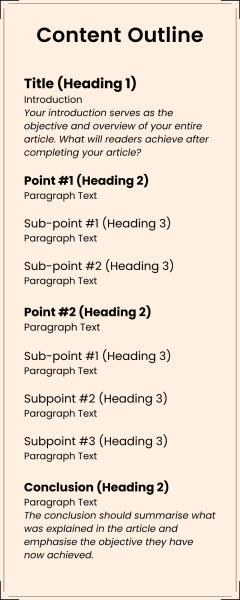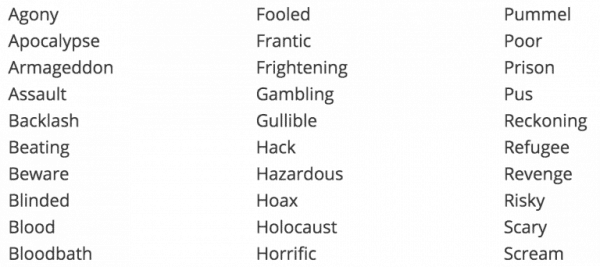Content is the lifeblood of digital marketing. In this day and age, where an endless stream of content is readily available for anyone to find and consume, it is crucial to create well-written and engaging content to stand out from the crowd.
While there is a plethora of different content types for you to include in your digital marketing strategy, one that every business should utilise is blog writing.
Blog posts are one of the most versatile content types you can create; it can be anything from a how-to guide to a fun and snappy listicle. Blog posts are also one of the best ways to gain higher traffic, leads, and conversions as it is a form of content that provides value. When users search for something that is relevant to or answered in your blog post, they get exposed to your business and appreciate the information provided.
If you have yet to start blog writing, keep reading as we discuss its importance as well as delve into what the best practices are when it comes to blog content.
Why You Should Start Blog Writing
The benefits associated with blog writing are varied and, ultimately, impressive. Firstly, writing blog posts go hand-in-hand with improving your Search Engine Optimisation (SEO) efforts. If you’re unfamiliar with the process of SEO, it is essentially undertaking certain tactics and actions to increase your ranking on the Search Engine Results Page (SERP).
An organic form of promotion, SEO allows your brand to be easily found by users when they search for certain keywords that are relevant to your business.
To give a brief explanation, the more these certain keywords are used by your business’ online channels, the more likely you are to be associated with those keywords and appear in users’ search results. The more you use these keywords on your website, the more relevant you are to someone’s search and the higher you’ll appear on the SERP.
It’s easy to see why improving SEO would be beneficial to your business as it’s a cost efficient and organic method of driving brand awareness, gaining traffic, and increasing leads and conversions.
For a more in-depth look into SEO, check out our guide: What is SEO Marketing and How Does It Work?
Blog writing is also a great way of increasing engagement as well as the time spent on your website/pages. When you write an interesting and engaging blog post, users who chance upon it are more likely to read through the whole post in order to gain information or receive a solution to their problems. It can also generate interest in your business as a whole, which could drive them to explore other sections of your website.
Additionally, blog writing that is done well and with a level of expertise helps establish yourself as an authority in your industry. When you create quality content that shows off your knowledge and expertise in your field, you become seen as an authoritative source of information, solidifying your position in your industry.
Lastly, one of the most fulfilling benefits of blog writing is the value you add into your customers’ lives. When you provide them with content that is entertaining, educational, informative or problem-solving, you add value beyond what products or services you sell. This leads to a trusting and meaningful relationship between you and your audience, which is not always easy to achieve.
If you have been convinced of the necessity of hosting and creating content for a blog, let’s dive into the best practices you can undertake.
Best Practices for Blog Content Writing
While there are many different practices that go into making a blog post great, there are a few foundational tactics that you can use to ensure your blog content is the best it can be.
2.1 Optimise Keywords
A cornerstone of SEO, keywords are a word or set of words that are relevant to your business and that users are searching for in high volumes. When a user conducts a search on search engines like Google, the results are ranked by its relevance to the keywords used.
Users are less likely to visit page two of the Search Engine Results Page (SERP), which is why it is imperative to be keyword-optimised, so as to ensure you are within the first SERP or, even better, the first result.
There are many factors that Google’s algorithm takes into account when ranking results, however, being keyword optimised (using the relevant keywords in your article) greatly helps your chances of ranking high.
When researching topics for every blog post, conduct keyword research to choose Primary, Secondary, and Additional keywords that will be used throughout the post.
The Primary keyword is the main focus and keyword for the blog post and is to be used throughout and within the title itself. Secondary keywords are supplementary to the Primary keyword and are to be used in subheadings and paragraphs. Additional keywords are essentially the same as Primary and Secondary keywords but phrased differently, to ensure that Google will register it.
As an example, if your article was titled “11 Tips to Become More Eco-Conscious”, you could find yourself with keywords such as:
-
- Primary keyword: eco-conscious
- Secondary keywords: recycling, environmentally friendly, waste free, climate change
- Additional keywords: eco consciousness, how to recycle, reducing waste, how to become eco conscious
For a more in-depth look on keyword research, take a look at our guide on How to Conduct Keyword Research for SEO.
2.2 Create a Comprehensive Outline
Before you write any blog post, you need to have an idea of what the final post will look like, how it will flow, and which topics it will cover. The key to ensuring your final work is structured well and doesn’t veer off course is to create a comprehensive outline.
An outline should include the proposed topic and should break down each subtopic into different sections and what each section should contain. When you create a comprehensive outline, you can be sure the blog post will flow well and hold readers’ attention. It also allows for easier writing as you already know the subtopics you will be exploring.
While there are different ways to create an outline, — and you should always create one that works best for you — here’s a simple example of an outline to follow.

In each section, include a few points on what it should contain to prevent going off-topic when writing. While you don’t have to write entire paragraphs in your outline, be as detailed as possible to ensure an easier and seamless writing experience.
2.3 Establish Expertise
When you create content, especially blog posts that are meant to be informative and educational, readers will expect you to have expertise in the subject. They want to know who is writing the information they’re gathering; otherwise, there’s less credibility to what’s being said and might not be taken as seriously.
In particular, content regarding specialised topics such as health, medicine, science, should be written by, or with, the aid of professionals and experts in that specific field. When you write a blog post about a highly specialised topic without credentials, it can make you appear unqualified and untrustworthy.
While it may be easier said than done, you should aim to at least work with an expert or professional in the field when crafting a blog post to ensure there is undoubtable expertise. In addition to that, always include a short author biography that details the writer’s experience in the field and highlights the relevant experience they have on the topic. When readers are faced with information like that, it could soothe any concerns they may have regarding credibility.

2.4 Write Long Form Copy
In a study by Backlinko, it was found that longform content of 3,000 – 10,000 words performed better and tended to receive an average of four referring domains, which is when another website links to that specific webpage. This greatly boosts your SEO efforts, increasing your chances of ranking higher on the SERP.
While it may seem difficult to create blog posts with such a high word count, there are a few tactics you can use to lengthen your copy.
Educational Guides
Firstly, focus on creating how-to guides or other education guides. Step-by-step guides are more likely to have a higher word count as it is detailing in-depth processes. You can create guides on specific topics relevant to your industry that people are commonly searching.
For example, if you are a business offering eco-conscious products, you may want to look into creating guides such as “How to Practise Eco-Consciousness in Your Everyday Life.” or “A Step-by-Step Guide on Recycling”. When you create comprehensive guides such as the examples given, you are sure to create lengthy blog posts while also providing a solution to users’ problems.
Expand on Each Pillar
Secondly, try to expand the topic of each blog post. Once you have chosen an overlying topic for a post, conduct as much research as possible and try to connect relevant subtopics to the topic at hand. For example, if your chosen topic is something along the lines of “How to Make Recycling a Habit.”, don’t jump straight into your tips and tricks.
Instead, explain what recycling is and why it is such an important process to make a habit. You can also discuss climate change and how it affects everyone or even break down a recent study that emphasises on the impact recycling has on the environment.
When you expand your scope adequately enough, you lengthen your copy while also providing even more helpful, useful, and valuable information to your audience. Besides improving your chances of gaining backlinks, you also help to establish yourself as a beacon of knowledge in your industry.
For more examples of longform blog posts, check out these two posts from Equinet Academy:
2.5 Use Trustworthy Sources
In every piece of content you write, you need to include reputable and trustworthy sources. Back up your statements and facts to establish yourself as a credible source of information yourself.
As mentioned in an earlier point about establishing expertise, a similar rationale applies here. Audiences want genuine and proven statements of facts when they are seeking out information, education, or a solution. They don’t want to be faced with inaccuracies and deceptions.
Therefore, it is absolutely critical to use high-quality, reputable, and trustworthy sources in your blog writing. Your audience may begin to distrust you if you provide them with false information.
An example of a trustworthy source when it comes to figures and statistics is Statista. It is an authoritative source as it is a website that specialises in market and consumer data. They are known for being accurate in their figures and are definitely one to check out when writing your blog posts.
Generally, it is best practice to research some of the undeniable sources of knowledge in your industry or related fields and gather them into a list of trusted sources. From there, you will have a collection of the top sources that can be used in your blog writing.
2.6 Internal and External Links
If you’re familiar with SEO, you may have heard of the importance and necessity of link building, both internal and external. Internal links refer to links that direct users to other web pages and sections of your website while external links direct users to other websites.
However, there are many other benefits to building both links — internal links, for example, can simplify the customer experience journey by providing immediate access to the mentioned resource or product.
In reference to SEO, building internal links can make Google view your page as more valuable and therefore, more relevant to users who search for related keywords. Building external links can create relationships with the websites you link to. If they notice traffic onto their website directed from your web page, this can potentially lead to gaining backlinks from them.
Including external links is also a form of providing a source to your statements and facts, which helps you appear more credible, especially if the external link is from a well-trusted site. Including internal links also can improve the time spent on your website and decrease your overall bounce rate.
There is no hard-and-fast rule for how many links you should include in each blog post but it is generally good to include internal links where possible and ensure it is contextually accurate. As for external links, if you’re using another website as a direct source for a statement or fact, include it as an external link to properly attribute credit.
2.7 Write Evergreen Content
Evergreen content refers to content that is search-optimised and will forever stay relevant i.e. is not time-bound and not reliant on passing trends. When you create evergreen content, you create something that is timeless, for any user to find valuable regardless of the time.
When you create content that is based on passing fads or timely events, you may see a spike in traffic but it will be only temporary. Once that trend or event has passed, users will no longer be searching for that topic and there will be an inevitable drop in traffic. However, with evergreen content, you can get a steady and continuous flow of traffic onto your blog post which would benefit your business more in the long-term.
How do you write evergreen content?
Firstly, conduct some keyword research and find keywords with a high search volume. To use the earlier example of an eco-conscious company, let’s try using the helpful keyword research tool Answer the Public.

Using the keyword “eco conscious”, this handy tool maps out the questions often searched for containing that keyword. From here, you can get some great ideas for evergreen content topics such as “how to be more eco conscious”. Using this result, you can craft an article entitled “11 Ways to be More Eco-Conscious” and find yourself getting a continuous stream of traffic.
2.8 Read Other Blogs
This should go without saying but, in order to write excellent blogs yourself, you need to explore and read other blogs. When you read other blogs, you can gauge what writing styles, topics, types of posts, tones etc. perform the best or are the most well-received while also discerning what definitively does not.
If you haven’t already, look into your competitors and what content they create — if they have a blog, read through their posts. From there, you can gauge their level of competency and if their posts are engaging to you as a reader. When going through competitors’ content, you can also generate ideas for your own content, though you should refrain from outright copying them.
When you read other blogs, you broaden your knowledge and learn what’s more likely to work. Additionally, you can also improve your language skills which will improve your blog post content quality.
2.9 Be Detailed
When you write any blog post, you always have to include relevant details to, firstly, substantiate the points being made and to, secondly, avoid sounding too vague and ignorant on the chosen topic.
When you are already an expert on the subject at hand, you may forgo certain details because you already hold that information. However, for readers who lack the knowledge and experience to understand the chosen topic, leaving out details or being too vague might cause some confusion and uncertainty.
As such, you need to be as detailed as possible when writing. With any topic, you need to explain each point adequately and thoroughly, to ensure there are no misconceptions on the reader’s end.
In addition, being detailed helps to establish your authority in your industry and also can deepen the relationship between you and your audience. Refraining from skimping on details and instead being thorough and comprehensive could help you appear to be more knowledgeable and trustworthy on the topics you discuss.
While it may be hard to ensure your work is adequately detailed, a simple way to circumvent a lack of details is to enlist the help of a proofreader. It could be a fellow colleague or even a friend or family member. When you have someone read through your work, they can help you discern which parts may require more details, to avoid confusion or misconceptions.
2.10 Utilise Power Words
Power words are words that can trigger psychological responses in readers, and it’s something every copywriter should utilise in their blog writing. Essentially, power words are persuasive and influential terms which help convince readers to make a specific chosen action.

When you create a blog post, there should always be an objective to it; you should want readers to act upon something when they’re done reading. Although blog posts should always refrain from being purely promotional and offer substantial value to readers, you should also want to increase your conversions with the help of your blog posts.
While it’s a fine line to thread, using power words can subtly plant your desired actions into readers’ minds, convincing them into taking that action.
2.11 Conduct a Content Audit
If you already run a blog but have yet to see the positive results of your labour, try conducting a content audit. A content audit is a process where you evaluate and analyse the performance of your previously published content, to improve your content strategy.
While it may be tempting to focus solely on continuously churning out new content, it is best practice to occasionally take a step back and evaluate your already existing content. Doing so helps you understand what has and hasn’t been working for your brand which, in turn, allows you to make changes to the content you write and optimise it for peak performance.
To conduct a content audit, you need to collate the URLs of every blog post you want to analyse. Categorise them in a way that seems rational to you; whether it’s by the stage in the buyer’s journey, content type, length, date, or author.
From there, you can utilise Google Analytics to analyse the performance of each blog post in terms of traffic, bounce rate, time spent, engagement, and conversion.
Key Takeaways
With blog posts being one of the most superfluous content types available, there is a plethora of ways you can optimise and perfect your blog writing. However, following these best practices provides a solid foundation for you to build upon.
If you want to learn more about creating compelling blog posts, check out our 2-day WSQ Copywriting and Content Writing course which covers all you need to know to create powerful copy.
We also hold a Certified Digital Marketing Strategist (CDMS) Programme which covers the following six modules:
- Digital Marketing Strategy
- Content Marketing Strategy
- Search Engine Optimisation
- Digital Advertising
- Social Media Marketing
- Digital Marketing Analytics with Google Analytics
The completion of these modules will lead the learners to attain a Certified Digital Marketing Strategist Certificate, bringing you one step closer to being a fully-fledged digital marketer. All of these courses are WSQ accredited and available for up to 70% subsidy.
Never Miss a Post
Receive the latest blog articles right into your inbox.
Tom Goh
Tom is a native Digital and Content Strategist with 20 years of experience across Tech, Banking, and Digital Advertising and Media verticals. He is also the lead trainer for Equinet Academy’s Content Marketing Strategy and Advanced Content Marketing Strategy course. In his spare time, Tom is actively in the start-up scenes providing pro bono advice to budding entrepreneurs.



Reader Interactions